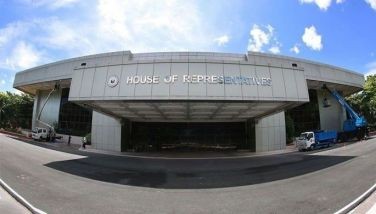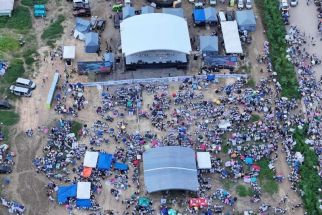Can Duterte say no to the Red Dragon?

WHEN will President Rodrigo Duterte wake up to the security threats posed by the escalating military presence of China in the Philippines’ exclusive economic zone? When and where will he draw the line – if ever?
Professing friendship, China serves Duterte a lauriat of investment promises and massive loans (that look to skeptics like baits to a debt trap). Meanwhile, the Red Dragon has been building up reefs in the West Philippine Sea into islands now harboring military installations.
A report in The Diplomat this week analyzes China’s setting up missiles systems on Fiery Cross, Subi, and Mischief reefs in the Spratly group near the southern tip of Palawan. Intelligence photographs of the military installations have been uploaded in the Internet.
On Jan. 6, two Xian Y-7 military transport planes were photographed on a runway built on Panganiban (Mischief) reef. The foreign office said it might file a protest if warranted, but it was not clear if it did.
Photographs were also published earlier showing that China has transformed Kagitingan (Fiery Cross), Calderon (Cuarteron), Burgos (Gaven), Mabini (Johnson South), Zamora (Subi) and McKennan (Hughes) reefs into artificial islands. Malacañang did not show much concern.
China has been militarizing maritime features in the West Philippine Sea in full view of its neighbors, some of them counter-claimants. Crisscrossed by sea lanes where some $3.5 trillion in goods pass yearly, the disputed area has become a conflict flashpoint.
President Duterte cannot be unaware that Beijing, having gained control the WPS features now bristling with airstrips, reinforced shelters, radar and missile sites, is not likely to give them up. What must he do?
Has Duterte, dubbed by Time magazine as a “strongman,” been compromised or intimidated by China into acquiescence? Whatever, he has a clear obligation to explain to the nation his failure to protect Philippine territory against foreign incursions.
With the political opposition in disarray and the co-equal branches of government that should check and balance the Executive department having been intimidated into silence, who will call Duterte to account for his defeatist deference to China?
What ever happened to the President’s solemn oath to preserve and defend the Constitution, which, among other things, bans foreign military bases or facilities on Philippine territory unless allowed under a treaty duly concurred in by the Senate?
• Chinese missile sites off Palawan
WRITING in The Diplomat May 5, Steven Stashwick said among other things: “China appears to have deployed long-range anti-ship cruise missiles and air-defense missiles to the Spratly Islands, providing the islands with offensive reach for the first time. The move dashes hopes across the region that China would refrain from, or at least limit, its militarization of the extensive bases it has built on reclaimed coral reefs in the heavily disputed islands.
“Intelligence sources told CNBC News that China had placed supersonic YJ-12B anti-ship cruise missiles and HQ-9B anti-air missiles on Fiery Cross, Subi, and Mischief Reefs in the Spratlys. China’s Ministry of Foreign Affairs tried to downplay the significance of the deployment, but the White House Press Secretary said that China would face consequences for the missile emplacements and its continued militarization of its Spratlys features, without elaborating on what those might be.
“China occupies seven features in the Spratly Islands, and since 2013, it has reclaimed over 3,000 acres of land to build military bases and port facilities on. Fiery Cross, Subi, and Mischief Reefs are the three largest islands China has reclaimed and are home to the most extensive facilities, including command and control, sensor arrays, runways capable of accommodating every military aircraft in the PLA inventory, hardened aircraft shelters, bunkers for fuel and munitions, and emplacements for missile batteries.
“China previously deployed short-range missiles and point-defense systems like anti-aircraft guns and close-in-weapons-systems to the islands, designed to defeat incoming missiles. Statements from China’s Ministry of Foreign Affairs that the island buildups and point-defense systems did not constitute ‘militarization’ were a rhetorical strain on the term, but it is true that those earlier systems had mostly defensive utility and were broadly non-threatening.
“A Chinese Ministry of Foreign Affairs spokeswoman addressed this new deployment with the same justification it has used for those earlier short-range systems, that they were ‘national defense facilities.’ (She) said that no other countries needed to worry about the new anti-ship and anti-air missiles unless they had an ‘invasive intention.’
“This is true to a point, and was likely a jab directed at the United States, which has prepared studies and plans in recent years that depict conducting offensive amphibious operations against Chinese-occupied islands in the South China Sea. But while anti-ship cruise missiles and anti-air missiles can play a defensive role, unlike the point-defense systems deployed earlier, they are capable of offensive force projection as well.
“The earlier point-defense systems’ short ranges meant they could engage incoming missiles fired at the bases they were installed on but could not reach the warships or aircraft that fired them, so foreign warships and aircraft operating even in close proximity to the Spratlys did not need to be concerned by them.
“However, the long ranges of the YJ-12 and HQ-9 missiles allow them to engage warships and aircraft far beyond the horizon. That range means they can be used for defense by engaging ships and aircraft that are attacking the Spratlys, but also that they can also project control of the sea and airspace around them against ships and aircraft merely traversing the skies around them.
“Estimates for the YJ-12’s range vary from 160 to 250 nautical miles, though some claim it can reach nearly 300, and the HQ-9B’s range is believed to be around 100 nautical miles. Their placement on Subi, Mischief, and Fiery Cross Reefs means that China could theoretically engage ships in most of the southern half of the South China Sea, and engage aircraft flying anywhere in the vicinity of the wider Spratly Islands.”
* * *
ADVISORY: All Postscripts can be accessed at manilamail.com. Follow author on Twitter as @FDPascual. Email feedback to [email protected]
- Latest
- Trending




























